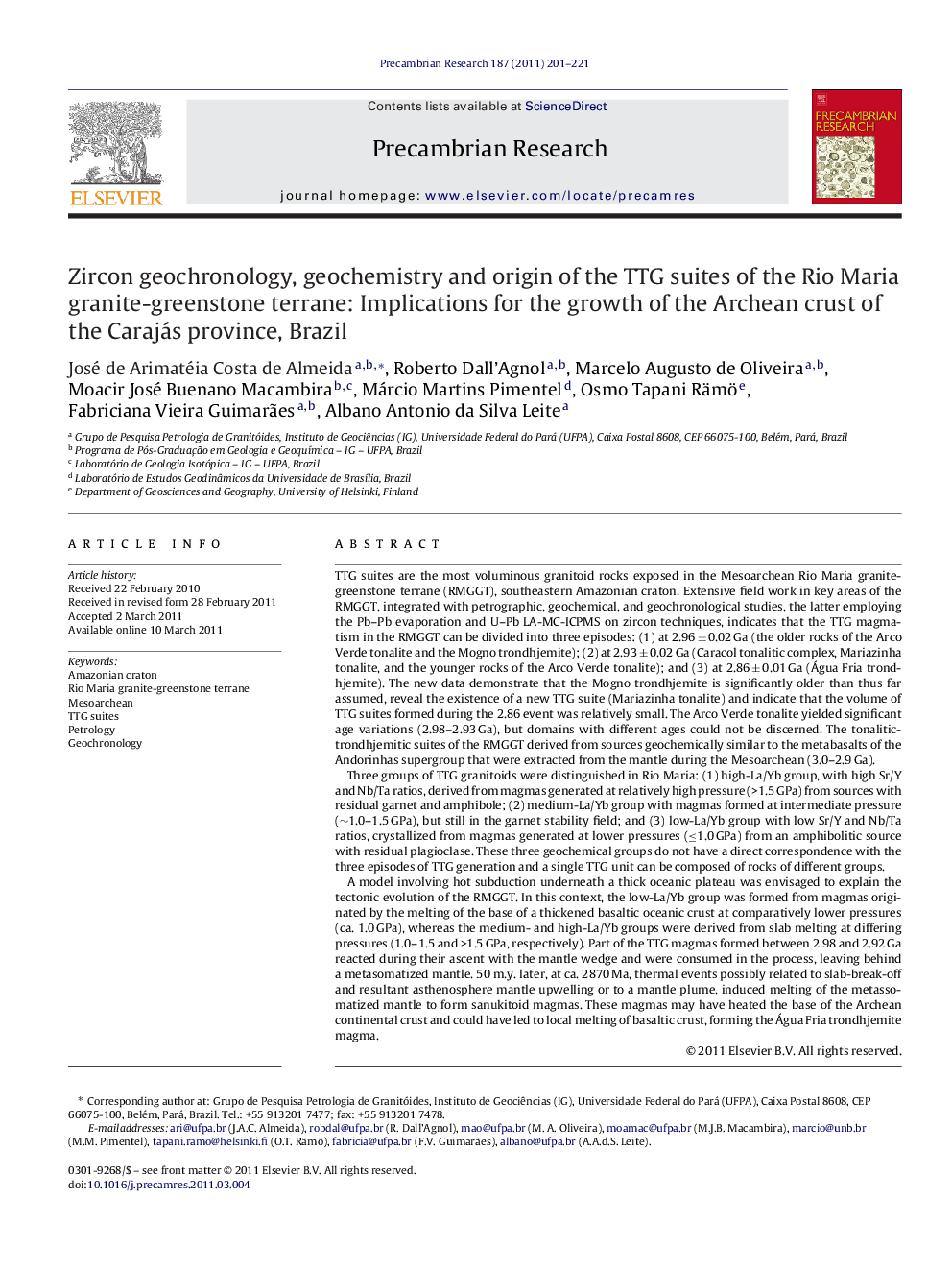| کد مقاله | کد نشریه | سال انتشار | مقاله انگلیسی | نسخه تمام متن |
|---|---|---|---|---|
| 4723846 | 1639670 | 2011 | 21 صفحه PDF | دانلود رایگان |

TTG suites are the most voluminous granitoid rocks exposed in the Mesoarchean Rio Maria granite-greenstone terrane (RMGGT), southeastern Amazonian craton. Extensive field work in key areas of the RMGGT, integrated with petrographic, geochemical, and geochronological studies, the latter employing the Pb–Pb evaporation and U–Pb LA-MC-ICPMS on zircon techniques, indicates that the TTG magmatism in the RMGGT can be divided into three episodes: (1) at 2.96 ± 0.02 Ga (the older rocks of the Arco Verde tonalite and the Mogno trondhjemite); (2) at 2.93 ± 0.02 Ga (Caracol tonalitic complex, Mariazinha tonalite, and the younger rocks of the Arco Verde tonalite); and (3) at 2.86 ± 0.01 Ga (Água Fria trondhjemite). The new data demonstrate that the Mogno trondhjemite is significantly older than thus far assumed, reveal the existence of a new TTG suite (Mariazinha tonalite) and indicate that the volume of TTG suites formed during the 2.86 event was relatively small. The Arco Verde tonalite yielded significant age variations (2.98–2.93 Ga), but domains with different ages could not be discerned. The tonalitic-trondhjemitic suites of the RMGGT derived from sources geochemically similar to the metabasalts of the Andorinhas supergroup that were extracted from the mantle during the Mesoarchean (3.0–2.9 Ga).Three groups of TTG granitoids were distinguished in Rio Maria: (1) high-La/Yb group, with high Sr/Y and Nb/Ta ratios, derived from magmas generated at relatively high pressure (>1.5 GPa) from sources with residual garnet and amphibole; (2) medium-La/Yb group with magmas formed at intermediate pressure (∼1.0–1.5 GPa), but still in the garnet stability field; and (3) low-La/Yb group with low Sr/Y and Nb/Ta ratios, crystallized from magmas generated at lower pressures (≤1.0 GPa) from an amphibolitic source with residual plagioclase. These three geochemical groups do not have a direct correspondence with the three episodes of TTG generation and a single TTG unit can be composed of rocks of different groups.A model involving hot subduction underneath a thick oceanic plateau was envisaged to explain the tectonic evolution of the RMGGT. In this context, the low-La/Yb group was formed from magmas originated by the melting of the base of a thickened basaltic oceanic crust at comparatively lower pressures (ca. 1.0 GPa), whereas the medium- and high-La/Yb groups were derived from slab melting at differing pressures (1.0–1.5 and >1.5 GPa, respectively). Part of the TTG magmas formed between 2.98 and 2.92 Ga reacted during their ascent with the mantle wedge and were consumed in the process, leaving behind a metasomatized mantle. 50 m.y. later, at ca. 2870 Ma, thermal events possibly related to slab-break-off and resultant asthenosphere mantle upwelling or to a mantle plume, induced melting of the metassomatized mantle to form sanukitoid magmas. These magmas may have heated the base of the Archean continental crust and could have led to local melting of basaltic crust, forming the Água Fria trondhjemite magma.
► TTG suites are the most voluminous granitoid rocks of the Mesoarchean Rio Maria terrane.
► The Rio Maria TTG suites are divided into three episodes: 2.96 ± 0.02 Ga, 2.93 ± 0.02 Ga and 2.86 ± 0.01 Ga.
► There are three geochemical groups of TTGs in Rio Maria terrane: high, medium and low (La/Yb) TTGs.
Journal: Precambrian Research - Volume 187, Issues 1–2, May 2011, Pages 201–221